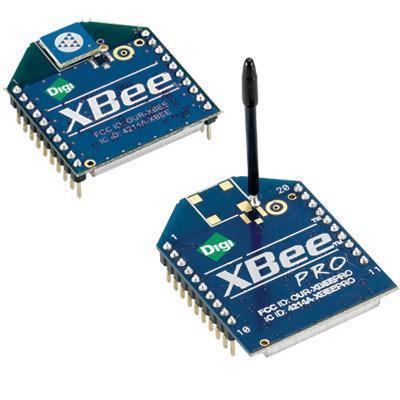
XBee Digimesh - Wire antenna
Tutti i prezzi sono IVA inclusa
DIGI Part #: XB24-DMWIT-250
XBee and XBee-PRO DigiMesh 2.4 embedded RF modules provide wireless connectivity to end-point devices using a globally deployable 2.4 GHz transceiver.
These modules use the DigiMesh networking protocol. This innovative, peer-to-peer network offers users added network stability through self-healing, dense network operation and support for sleeping routers, extending the operational life of battery dependent networks.
XBee modules are ideal for low-power, low-cost applications. XBee-PRO modules are power-amplified versions of XBee modules for extended-range applications. Products in the XBee family are easy to use, share a common hardware footprint, and are fully interoperable with other XBee products utilizing the same technology .
They are available in a variety of different protocols to suit different applications, enabling users to substitute one XBee module for another with minimal development time and risk. Digi’s unsurpassed offering of Drop-in Networking products provide users with seamless communication between devices. XBee adapters deliver wireless connectivity to electronic devices in wired networks. XBee XTenders provide long-range backhaul and data conversion between 2.4 GHz and 900MHz. ConnectPort™ X gateways enable users to access and configure remote devices in a network.
The ZigBee Protocol
The ZigBee protocol was engineered by the ZigBee Alliance, a non-profit consortium of leading semiconductor manufacturers, technology providers, OEMs and end-users worldwide. The protocol was designed to provide OEMs and integrators with an easy-to-use wireless data solution characterized by low-power consumption, support for multiple network structures and secure connections.
The ZigBee Advantage
The ZigBee protocol was designed to carry data through the hostile RF environments that routinely exist in commercial and industrial applications.
ZigBee protocol features:
- Low duty cycle - Provides long battery life
- Low latency
- Support for multiple network topologies: Static, dynamic, star and mesh
- Direct Sequence Spread Spectrum (DSSS)
- Up to 65,000 nodes on a network
- 128-bit AES encryption – Provides secure connections between devices
- Collision avoidance
- Link quality indication
- Clear channel assessment
- Retries and acknowledgements
- Support for guaranteed time slots and packet freshness
Secure Connections
The ZigBee specification provides a security toolbox approach to ensuring reliable and secure networks. Access control lists, packet freshness timers and 128-bit encryption based on the NIST Certified Advanced Encryption Standard (AES) help protect transmitted data.
ZigBee Applications
ZigBee enables broad-based deployment of wireless networks with low-cost, low-power solutions. It provides the ability to run for years on inexpensive batteries for a host of monitoring applications: Lighting controls, AMR (Automatic Meter Reading), smoke and CO detectors, wireless telemetry, HVAC control, heating control, home security, Environmental controls, drapery and shade controls, etc.
| Standard | ZigBee™ 802.15.4 |
Wi-Fi™ 802.11b |
Bluetooth™ 802.15.1 |
|---|---|---|---|
|
Transmission Range (meters) |
1 – 100*
|
1 - 100
|
1 – 10
|
|
Battery Life (days) |
100 – 1,000
|
0.5 – 5.0
|
1 - 7
|
|
Network Size (# of nodes) |
> 64,000
|
32
|
7
|
|
Application |
Monitoring & Control
|
Web, Email, Video
|
Cable Replacement
|
|
Stack Size (KB) |
4 – 32
|
1,000
|
250
|
|
Throughput kb/s) |
20 – 250
|
11,000
|
720
|
* MaxStream’s XBee-PRO Module yields 2 – 3x the range of standard ZigBee Modules (up to 1200 meters).
Use Case Scenario
It is 4:00 a.m. on a farm in Iowa. Sensors distributed throughout the fields report the moisture content in the soil and humidity of the air. The staff on the farm uses this data to decide where and when to water for optimum effect. The information also serves as an early warning system for environmental issues such as frost. Precious resources are used more efficiently and productivity increases.
The sensors distributed in the field are interconnected in a “mesh” network. If a sensor node goes down, the network is self-healing; the nodes are able to connect with one another dynamically, finding another route to stay connected within the network.
Mesh Networks
A key component of the ZigBee protocol is the ability to support mesh networks. In a mesh network, nodes are interconnected with other nodes so that at least two pathways connect each node. Connections between nodes are dynamically updated and optimized in difficult conditions. In some cases, a partial mesh network is established with some of the nodes only connected to one other node.
Mesh networks are decentralized in nature; each node is self-routing and able to connect to other nodes as needed. The characteristics of mesh topology and ad-hoc routing provide greater stability in changing conditions or failure at single nodes.
MaxStream XBee & XBee-PRO Modules
MaxStream is a member of the ZigBee Alliance and has developed OEM solutions based on the ZigBee architecture. The XBee and XBee-PRO modules provide an easy-to-implement solution and a powerful boost to range and reliability to companies looking to offer ZigBee
